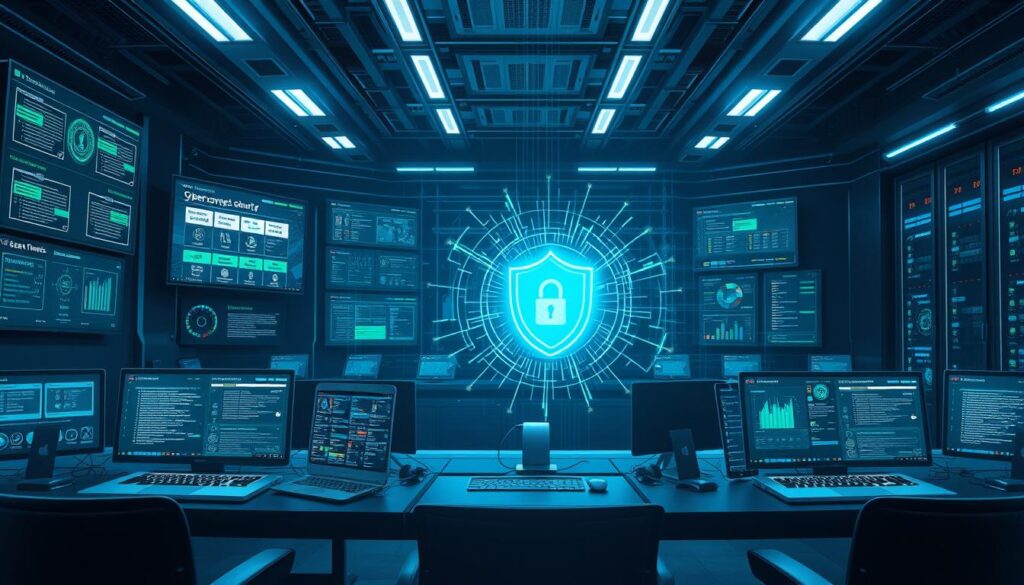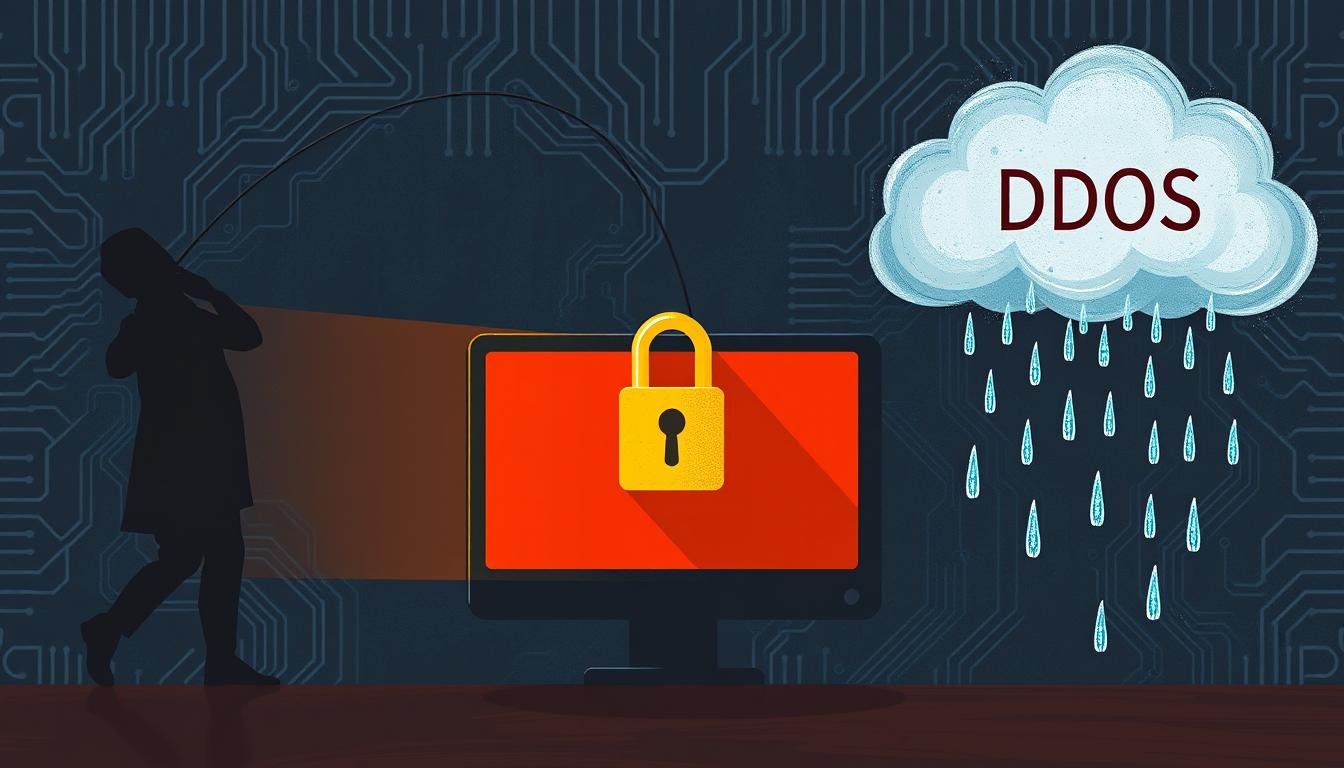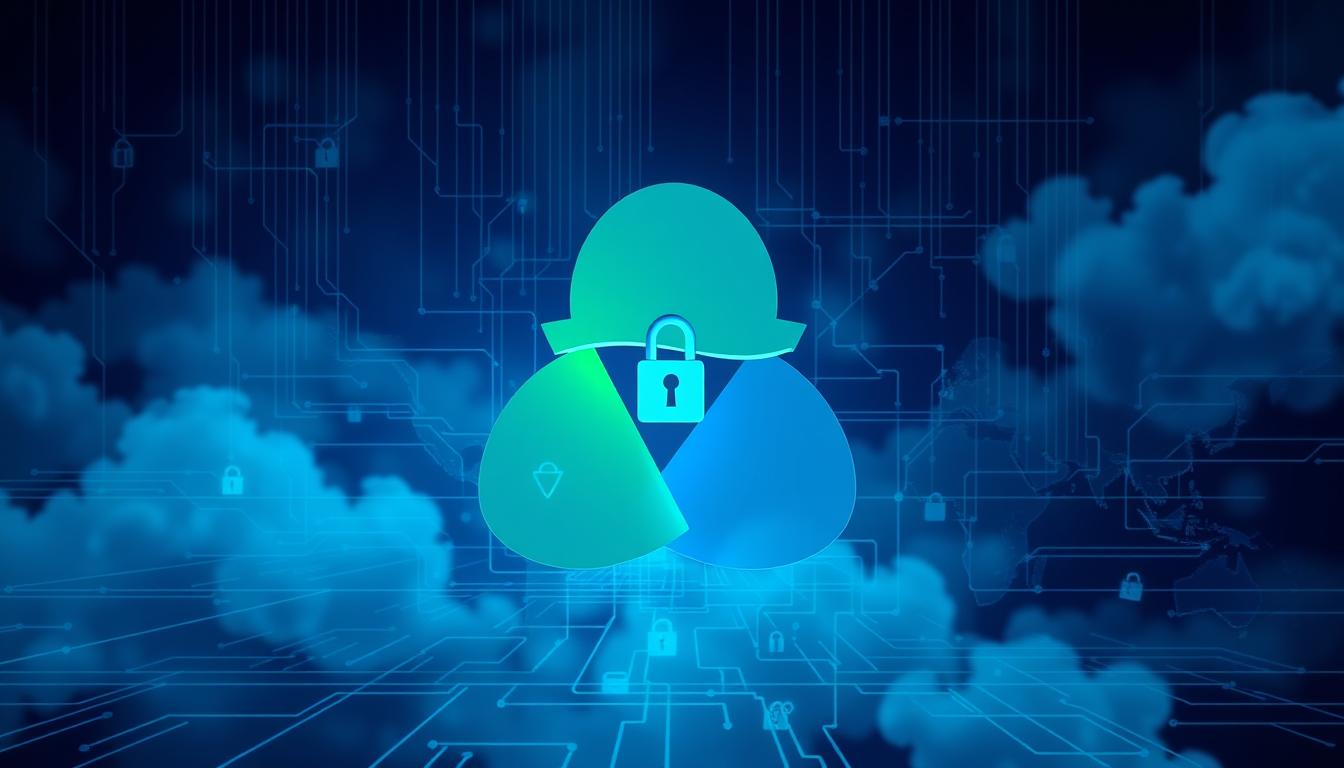Did you know cybercrime could cost the world $10.5 trillion by 20251? This shows how vital it is to know and spot common cyber threats today.
Welcome to Day 3 of our Cybersecurity Training. We’ll look closely at phishing, ransomware, and DDoS attacks. These threats are getting smarter, with phishing causing over 90% of data breaches2. You’ll learn how to keep your digital stuff safe.
The world of cyber threats is changing fast, with ransomware up 94% from 2022 to 20231. This rise in bad activities shows we need strong cybersecurity fast. By the end of this, you’ll know how to fight these threats and help keep the internet safer.
Key Takeaways
- Cybercrime costs are projected to reach $10.5 trillion annually by 2025
- Phishing is responsible for over 90% of data breaches
- Ransomware attacks have increased by 94% from 2022 to 2023
- Understanding phishing, ransomware, and DDoS attacks is crucial for cybersecurity
- Effective threat identification skills are essential for protecting digital assets
- Implementing robust cybersecurity measures is vital in the evolving threat landscape
Understanding Modern Cybersecurity Landscape
The digital age has brought us great convenience. But, it also brings big challenges in keeping our data safe. As cyber threats grow, we need strong cyber security more than ever.
Evolution of Cyber Threats
Cyber threats have changed a lot over time. From simple viruses to complex ransomware, the threats are now more advanced. Ransomware attacks jumped by over 150% from 2020 to 2021, showing how fast this threat is growing3.
The rise of Ransomware as a Service (RaaS) has made it easier for cybercrime groups to use advanced tools4.
Impact on Businesses and Individuals
Cyber attacks have big effects. About 60% of businesses hit by cyber attacks fail within six months3. The cost of a data breach went up to $4.88 million in 2023, a 10% jump from the year before5.
These numbers show how vital cyber security is for both companies and people.
Current Threat Statistics and Trends
Knowing the latest trends is key to good cyber security plans. Phishing attacks cause about 90% of all data breaches, showing how common they are3. Insider threats are also growing, with over 80% of companies facing at least one incident3.
The move to remote work has made our networks more vulnerable. This means we need strong zero trust security models4.
“In the digital age, cyber security is not just an IT issue, it’s a business imperative.”
As threats change, so must our defenses. Companies that keep checking for vulnerabilities can cut their attack surface by up to 60%3. With spending on global cybersecurity set to hit over $1.75 trillion from 2021 to 2025, it’s clear businesses are seeing the value in investing in cyber security5.
Identifying Common Cyber Threats: Phishing, Ransomware, and DDoS
In today’s digital world, identifying common cyber threats is key for everyone. Phishing, ransomware, and DDoS attacks are major threats to businesses and individuals.
Phishing attacks are a big worry, making up over 80% of reported cyber incidents. In 2022, 1 in 4 companies faced a phishing attack, losing about $1.6 million on average6. These attacks can lead to identity theft, financial loss, and unauthorized access to systems7.
Ransomware attacks have skyrocketed, with a 105% global rise in the last year. The average ransom payment hit $570,000 in 2023. Sadly, only 65% of companies that paid the ransom got their data back6. In 2024, the ransom is expected to be over $5.2 million, costing victims billions7.
DDoS attacks have also grown, with a 50% increase in 2022. These attacks last about 3 hours on average. Over 70% of companies faced a DDoS attack in the last 12 months6. These attacks can cost a lot, with an average loss of $113,000 in business8.
| Threat Type | Prevalence | Average Cost | Key Statistic |
|---|---|---|---|
| Phishing | 80% of incidents | $1.6 million per attack | 1 in 4 organizations affected |
| Ransomware | 105% increase | $570,000 average payment | 65% data recovery rate |
| DDoS | 50% increase | $113,000 in lost business | 70% of organizations affected |
It’s vital to understand these threats to create strong cybersecurity plans. Companies without a plan face higher costs during a data breach8. By knowing about phishing, ransomware, and DDoS, businesses can protect themselves better.
Deep Dive into Phishing Attacks
Phishing attacks are a big problem in cyber security. They cause over 90% of data breaches and cost businesses an average of $1.6 million per incident910. These attacks rely on human weakness, making it key to educate people to fight them.
Spear Phishing Techniques
Spear phishing aims at specific people or groups, with a 55% rise in attacks last year9. These targeted efforts make up 95% of all attacks, showing their success10. Scammers use personal details to make fake emails that trick victims.
Whaling Attacks
Whaling is a type of spear phishing that goes after high-profile people like CEOs. These attacks use social engineering to trick victims into sharing sensitive info or making fake transactions. The 2016 DNC email leak is a bad example of what can happen9.
Social Engineering Methods
Social engineering plays on human psychology to get around security. It uses tricks to build trust and exploit feelings like fear or urgency. A study found 75% of people can’t tell real emails from fake ones, showing the need for better awareness9.
Email Spoofing Tactics
Email spoofing tricks people into thinking emails are from trusted sources. Scammers use advanced methods to look like real emails. Now, 70% of phishing sites use HTTPS to look more real, making it harder to spot them9.
Companies that do regular phishing tests see a 20% better rate of catching fake emails10. This, along with strong security, is key to fighting phishing threats.
Understanding Ransomware Threats
Ransomware is a big problem in the world of cybersecurity. It locks your data and demands money to unlock it. In 2023, it caused 25% of all cyber attacks, leading to 21 days of downtime on average11.
Small businesses are hit hard, with 60% closing down within six months after an attack11.
Types of Ransomware
Ransomware has different types, each with its own way of causing trouble:
- Crypto-ransomware: Encrypts files, making them inaccessible
- Locker ransomware: Locks users out of their entire system
- Scareware: Tricks users into thinking their system is infected
Infection Vectors
Ransomware attacks often start with emails or links. About 70% of attacks come from these sources11. Phishing emails are a big problem, leading to 90% of successful breaches12.
Encryption Methods
Ransomware uses advanced encryption to lock your data:
| Encryption Type | Description | Difficulty to Decrypt |
|---|---|---|
| Symmetric | Uses same key for encryption and decryption | Moderate |
| Asymmetric | Uses public and private key pairs | High |
| Hybrid | Combines symmetric and asymmetric methods | Very High |
In 2023, cybercriminals demanded an average of $200,000 in ransom payments11. Yet, 70% of companies that paid the ransom still lost their data12.
To fight ransomware, businesses need to focus on cybersecurity training and strong prevention. Companies with good training saw a 70% drop in phishing attempts and ransomware attacks11. This shows how important education is in stopping these threats.
Analyzing DDoS Attack Patterns
Distributed Denial of Service (DDoS) attacks are a big threat to companies. In 2023, 80% of companies faced at least one DDoS attack. These attacks made up 8% of all cyber threats in the first half of the year6. It’s important to understand these patterns to spot threats like phishing, ransomware, and DDoS.
DDoS attacks flood servers with too much traffic, stopping operations. These attacks now last over two hours, up by 50%6. This long time makes networks more vulnerable and raises the risk of data breaches.
Volumetric attacks are the most common, making up 90% of DDoS attacks6. They aim to fill the target’s bandwidth, causing big downtime. Without strong defense, companies risk losing 70% more service time6.
The cost of DDoS attacks can be huge, up to $2.5 million per attack6. Small to medium businesses are often targeted, making up 70% of victims6. This shows the need for strong security for all businesses.
Attackers often use amplification methods, which exploit misconfigured servers. These methods are used in about 60% of attacks6. Also, 25% of attacks mix methods like SYN Flood and UDP Flood to hit harder6.
To fight these threats, companies should use strong passwords and multi-factor authentication. This can cut down unauthorized access by up to 99.9%13. Training employees on phishing and social engineering can lower successful attacks by 70%13. Using encryption standards like ECC, RSA, and AES is key, as encrypted data is 75% less likely to be stolen13.
As DDoS attacks get more complex, so must our defenses. Using advanced monitoring software, next-generation firewalls, and comprehensive security measures is vital to protect against these threats.
Essential Security Tools and Solutions
When fighting cyber threats, the right tools are essential. Let’s look at the main parts of a strong cybersecurity plan.
Antivirus Software
Antivirus software is the first defense against malware. It checks files, finds threats, and removes bad programs. Modern antivirus uses new methods like machine learning to catch new threats14.

Firewall Configuration
Firewalls block bad traffic from outside networks. They let good traffic in and out. Both hardware and software firewalls are key for network safety.
But, firewalls can’t catch all threats. They might miss new attacks or tricky phishing scams14.
Network Monitoring Tools
Network monitoring tools spot odd behavior and threats as they happen. They watch traffic and logs, alerting admins to anything strange. These tools are vital for keeping an eye on cloud services, where security is shared14.
| Security Tool | Primary Function | Limitations |
|---|---|---|
| Antivirus Software | Detect and remove malware | May struggle with unknown malware strains |
| Firewalls | Filter network traffic | Limited against sophisticated attacks |
| Network Monitoring Tools | Detect anomalies in real-time | Require proper configuration and analysis |
No single tool can protect you fully. A mix of tools, education, and updates is the best way to stay safe online15.
Prevention Strategies and Best Practices
In the world of cyber security, stopping threats before they start is essential. Companies need strong plans to protect against new hacking methods. Let’s look at ways to strengthen your defenses.
Employee Training Programs
A smart team is your strongest shield. Teach your team to spot phishing and social engineering tricks. Research shows 98% of cyber attacks use these tactics16. Regular training can lower the risk of falling prey to these attacks.
Security Policies Implementation
Creating detailed security policies is vital. Use the “least privilege” rule to limit who can access what data. This can help stop ransomware from spreading17. Good cyber security also means keeping software up to date and managing patches well.
Incident Response Planning
Be ready for the worst with a solid incident response plan. It should cover how to detect, contain, and recover from attacks. Follow the 3-2-1 backup rule: have 3 copies of data on 2 types of storage, with 1 copy offline17. This can save your data in a ransomware attack.
| Prevention Strategy | Effectiveness |
|---|---|
| Multi-Factor Authentication (MFA) | Decreases unauthorized access risk by ~99%18 |
| Regular Vulnerability Scans | Identifies up to 70% of security flaws18 |
| Proper Cybersecurity Policies | Reduces data breach likelihood by 50%18 |
By using these strategies, companies can greatly improve their cyber security. Remember, hacking methods are always evolving. So, staying alert and flexible is key to keeping your data safe.
Data Protection and Encryption Methods
In today’s digital world, keeping sensitive info safe is key for cyber security and stopping data breaches. Companies must use strong data protection plans to fight off new threats.
Encryption is a crucial tool for data safety. It changes data into something unreadable, so only those with the right keys can see it. Businesses should use strong encryption for data at rest, in transit, and while it’s being used to keep it private.
Data breaches can cause big problems. In the U.S., a breach can cost about $8 million and affect up to 25,575 user accounts19. These breaches can lead to big financial losses and hurt customer trust and a company’s reputation.
To fight cyber threats, companies should:
- Set up data classification systems
- Use both symmetric and asymmetric encryption
- Apply hashing techniques
- Look into new tech like homomorphic encryption
The world of cyber security is always changing. From November 2020 to October 2021, web app attacks hit many sectors. Finance saw 226 attacks, healthcare 173, and professional services 16420. This shows the need for strong data protection in all fields.
As cyber threats grow, so does the need for more cybersecurity experts. Big tech companies and schools are teaming up to help. They aim to cut the shortage of cybersecurity workers by 50% by 202520. This will help companies have the right people to protect their data well.
Security Incident Response Protocol
In today’s cyber world, having a strong security plan is vital. With new threats popping up, companies must be ready to spot, stop, and fix breaches fast.
Detection Procedures
Spotting threats early is key to lessening damage. Companies should keep an eye on their systems for odd behavior. In 2023, over 80% of businesses faced phishing, and ransomware attacks jumped by 30% from 2021 to 202221.
Using tools like Security Information and Event Management (SIEM) can help 84% of firms respond quicker to threats21.
Containment Strategies
Acting fast when a threat is found is essential. Quick steps stop the threat from spreading. Long-term plans make systems safer. In 2023, DDoS attacks caused 40% of cyber incidents, making fast action crucial21.
Recovery Process
The recovery phase is about getting rid of the threat and fixing systems. Having a team and plans can save a company $473,706 on average22. Regular checks help find weak spots and focus on the most critical issues.
| Incident Type | Prevalence | Impact |
|---|---|---|
| Phishing | 80% of organizations | Credential theft, data breaches |
| Ransomware | 30% increase in 2022 | Data encryption, financial loss |
| DDoS | 40% of cyber incidents | Service disruption, reputation damage |
With solid incident response plans, companies can safeguard their data and stay ahead of threats.
Compliance and Regulatory Requirements
In the world of cyber security, following rules isn’t just about avoiding fines. It’s key to keeping your organization safe from data breaches and threats. Cybersecurity compliance means following specific standards to protect sensitive info.
Rules like GDPR, HIPAA, and PCI DSS are the basics for data protection. These rules help organizations defend against cyber threats. Being compliant can greatly reduce risks, especially for small and medium-sized businesses23.
Not following these rules can lead to big problems. In 2022, the average cost of a data breach was $4.35 million24. This shows how important it is to follow these rules.
The Human Factor in Compliance
Human mistakes are a big part of cyber incidents. About 95% of cyber incidents are caused by human error, showing the need for good employee training23. Companies that train their employees well see a 45% drop in cyberattacks24.
Third-Party Risks and Compliance
It’s important to check third parties regularly to make sure they meet security standards. This is key because over 70% of companies don’t focus enough on third and fourth-party vendor risks24.
“Compliance provides a structured framework that helps organizations reduce their risk profile significantly.”
To stay compliant and improve cyber security, take these steps:
- Implement basic compliance measures
- Conduct regular compliance audits
- Use cloud solutions with built-in compliance features
- Develop a formal incident response plan
By focusing on compliance and regulatory needs, organizations can protect themselves better. Remember, compliance is just the beginning of a strong cyber security plan, not the end.
Future of Cybersecurity Threats
The world of cybersecurity is changing fast, with new dangers popping up all the time. In 2023, cybercrime cost a whopping $8 trillion. Experts predict this number will hit $10.5 trillion by 202525. We need to stay ahead of threats like phishing, ransomware, and DDoS attacks.
Emerging Attack Vectors
Advanced persistent threats (APTs) are getting smarter, often hiding for 150 days8. These sneaky attacks aim to steal data or mess with operations. With more IoT devices and cloud services, businesses must be extra careful.
AI-Powered Threats
Artificial intelligence is changing the game for both hackers and defenders. Hackers use AI to make phishing emails seem real, with 33% of people opening them8. But, companies are using AI to catch and stop these threats.
Preventive Technologies
Companies are using a layered security strategy to fight threats. This includes keeping software up to date, teaching employees about phishing, and using multi-factor authentication25. They also use advanced threat intelligence and automated systems to fight cybercrime.
The fight against online fraud and cyber threats will keep getting tougher. But, by keeping up with new threats and using the latest tech, businesses can stay safe in the digital world.
Conclusion
As we finish our look at cyber security and hacking, it’s clear we must stay alert. The world of cyber threats is changing fast. It’s expected to cost $13.82 trillion by 202826.
This big number shows we need strong defense plans and to keep learning. Phishing attacks, which cause 90% of data breaches, show how important it is to know about threats and use advanced threat detection systems27. Companies must focus on keeping their systems safe, as 60% of small businesses fail after a cyberattack28.
Using strong security tools, like two-factor authentication, is key. It can stop up to 99.9% of automated attacks27.
Looking to the future, artificial intelligence and machine learning will help fight threats26. As threats change, so must our ways of fighting them. By staying up-to-date, investing in security, and teaching others about cyber safety, we can make the internet safer for everyone.
FAQ
What are the three main cyber threats discussed in this training?
This training talks about phishing, ransomware, and DDoS attacks. These threats are common and can cause a lot of damage.
How has the cybersecurity landscape evolved over time?
Cybersecurity has changed a lot over the years. Early threats were simple, but now they are complex and hard to spot. This change makes it harder for businesses and people to stay safe.
What is spear phishing and how does it differ from regular phishing?
Spear phishing is a targeted attack. It’s different from regular phishing because it focuses on specific people or groups. It uses detailed information to trick victims, making it more dangerous.
What are the main types of ransomware?
There are two main types of ransomware. Crypto-ransomware encrypts files, and locker ransomware locks systems. Both demand money to unlock data or systems.
How do DDoS attacks work?
DDoS attacks flood a system with traffic from many sources. They can use a lot of bandwidth or target specific services. The goal is to make the system unavailable to others.
What are some essential security tools for protecting against cyber threats?
Important tools include advanced antivirus software, firewalls, and network monitoring. These tools help keep systems safe from threats.
Why is employee training important in cybersecurity?
Training is key because people can accidentally let threats in. Good training makes employees aware of dangers and helps prevent attacks.
What role does encryption play in data protection?
Encryption keeps data safe by making it unreadable without a key. It protects data at rest, in transit, and in use. Different encryption methods are used for different data types.
What is an incident response protocol and why is it important?
An incident response protocol is a plan for handling security threats. It’s important because it helps organizations quickly respond to threats. This minimizes damage and gets things back to normal fast.
How are AI and machine learning impacting the future of cybersecurity?
AI and machine learning are changing cybersecurity. They help both attackers and defenders. On the attack side, they make threats smarter. On the defense side, they help spot threats and respond faster.
Source Links
- 10 Common Cybersecurity Threats & Attacks [2024 Update] | ConnectWise – https://www.connectwise.com/blog/cybersecurity/common-threats-and-attacks
- 8 Common Types of Cyber Attack Vectors and How to Avoid Them – https://www.balbix.com/insights/attack-vectors-and-breach-methods/
- Understanding Cyber Threats in Today’s Digital World – https://www.tenable.com/principles/cyber-threats-principles
- What is Cyber Security? The Different Types of Cybersecurity – Check Point Software – https://www.checkpoint.com/cyber-hub/cyber-security/what-is-cybersecurity/
- What Is Cybersecurity? | IBM – https://www.ibm.com/think/topics/cybersecurity
- Cybersecurity Threats | Types & Sources | Imperva – https://www.imperva.com/learn/application-security/cyber-security-threats/
- What are Cyber Threats? – https://www.recordedfuture.com/threat-intelligence-101/cyber-threats
- Cybersecurity Threats: What They Are & How They Work Today | Splunk – https://www.splunk.com/en_us/blog/learn/cybersecurity-threats.html
- Understanding Top Cyber Attacks: A Deep Dive into Phishing Scams and Prevention Strategies – https://medium.com/@innovirtuoso/understanding-top-cyber-attacks-a-deep-dive-into-phishing-scams-and-prevention-strategies-4afcec8c2097
- Types of Cyber Attacks | Hacking Attacks & Techniques | Rapid7 – https://www.rapid7.com/fundamentals/types-of-attacks/
- Four Common Cybersecurity Threats | Gilsbar – https://www.gilsbar.com/4-common-cybersecurity-threats
- 12 Most Common Types of Cyberattacks – https://www.crowdstrike.com/en-us/cybersecurity-101/cyberattacks/common-cyberattacks/
- How can you identify cyber attack patterns and protect your data? – https://www.linkedin.com/advice/0/how-can-you-identify-cyber-attack-patterns-ig7nc
- Network Security Threats | Threats & Solutions | Darktrace – https://darktrace.com/cyber-ai-glossary/network-security-threats
- From Phishing to Ransomware: A Guide to Common Cyber Threats – Canary Trap – https://www.canarytrap.com/blog/common-cyber-threats-2/
- How To Prevent Cyber Attacks (Solutions & Best Practices) – https://purplesec.us/learn/prevent-cyber-attacks/
- How to Prevent Ransomware Attacks: Top 10 Best Practices | UpGuard – https://www.upguard.com/blog/best-practices-to-prevent-ransomware-attacks
- 10 Practices to Protect Your Organization from Cyber Threats – https://405d.hhs.gov/Documents/405d-infographic-10practices.pdf
- What is Data Security | Threats, Risks & Solutions | Imperva – https://www.imperva.com/learn/data-security/data-security/
- Cybersecurity: Meaning, Types of Cyber Attacks, Common Targets – https://www.investopedia.com/terms/c/cybersecurity.asp
- What is Cyber Threat Detection and Response? | UpGuard – https://www.upguard.com/blog/cyber-threat-detection-and-response
- What is Incident Response? | IBM – https://www.ibm.com/think/topics/incident-response
- Comprehensive Guide to Cybersecurity Compliance | Skillcast – https://www.skillcast.com/blog/compliance-mitigates-cybersecurity-threats
- What is Cybersecurity Risk? Definition & Factors to Consider in 2024 – https://securityscorecard.com/blog/what-is-cybersecurity-risk-factors-to-consider/
- Top Cybersecurity Threats [2023] – https://onlinedegrees.sandiego.edu/top-cyber-security-threats/
- 7 common Cybersecurity Threats and how to Mitigate them – https://10xds.com/blog/common-cybersecurity-threats-and-mitigation/
- 10 Cyber Security Threats: Protect Yourself from Phishing Emails – https://ntinow.edu/10-cyber-security-threats-protect-yourself-from-phishing-emails/
- What is a Cyberattack? – https://www.sentinelone.com/cybersecurity-101/cybersecurity/what-is-a-cyberattack/










